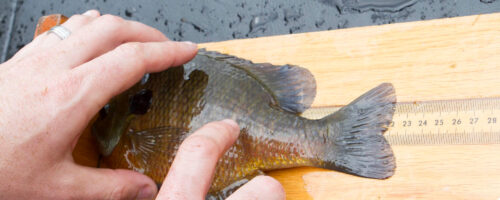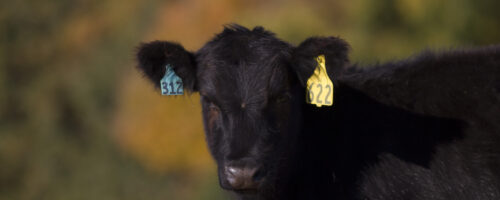Seine sampling a pond is a relatively easy way to learn quite a bit about fish, amphibian and invertebrate populations in a pond. Anyone willing to get wet and learn a few fish species can do it. The best time to seine sample a pond is during the summer months – June through September. At least three locations should be seined in each pond; however, more samples generally provide better results, especially in larger ponds. Try to avoid seining spots with wire, sticks, rocks, excessive vegetation or water deeper than 5 feet. Each seine sample should cover a quadrant shaped area.
This is accomplished by holding one end of the seine at the water’s edge while pulling the other end perpendicular to the bank into the water pushing the deep end back to the bank in an arc while
keeping the seine tight. The seine can be 15 to 50 feet long and 3 to 6 feet deep. The mesh size should be 1/8- to 1/4-inch square. The Noble Research Institute wildlife staff use a 20-foot x 6-foot seine with a 1/8-inch mesh. A 6- foot x 6-foot x 6 foot bag is attached to the center of this seine.
The numbers and sizes of each fish species captured should be recorded as well as the numbers of other aquatic animals captured such as tadpoles, salamander larvae, crayfish, insects and snails. The presence or absence of various things in the seine samples provides information about the fish populations in a pond. For example, the presence of many tadpoles, salamander larvae, mosquitofish, minnows or crayfish in seine samples indicates relatively few or no largemouth bass exist in the pond.
The presence of many insects indicates relatively few or no bream exist in the pond. Seine samples reveal the existence of some fish, amphibian and invertebrate species in a pond. During the first half of the summer, seining with small mesh sizes reveals the reproductive success of most sunfish species including largemouth bass, crappie and bluegill. However, seining does not sample several species well. Catfish, most fish larger than three inches, deep water species, mussels and most small invertebrates generally escape or avoid the seine.
Seine sample information coupled with fishermen’s catch records can tell a pond manager a great deal about the fish populations in a pond.



Comment